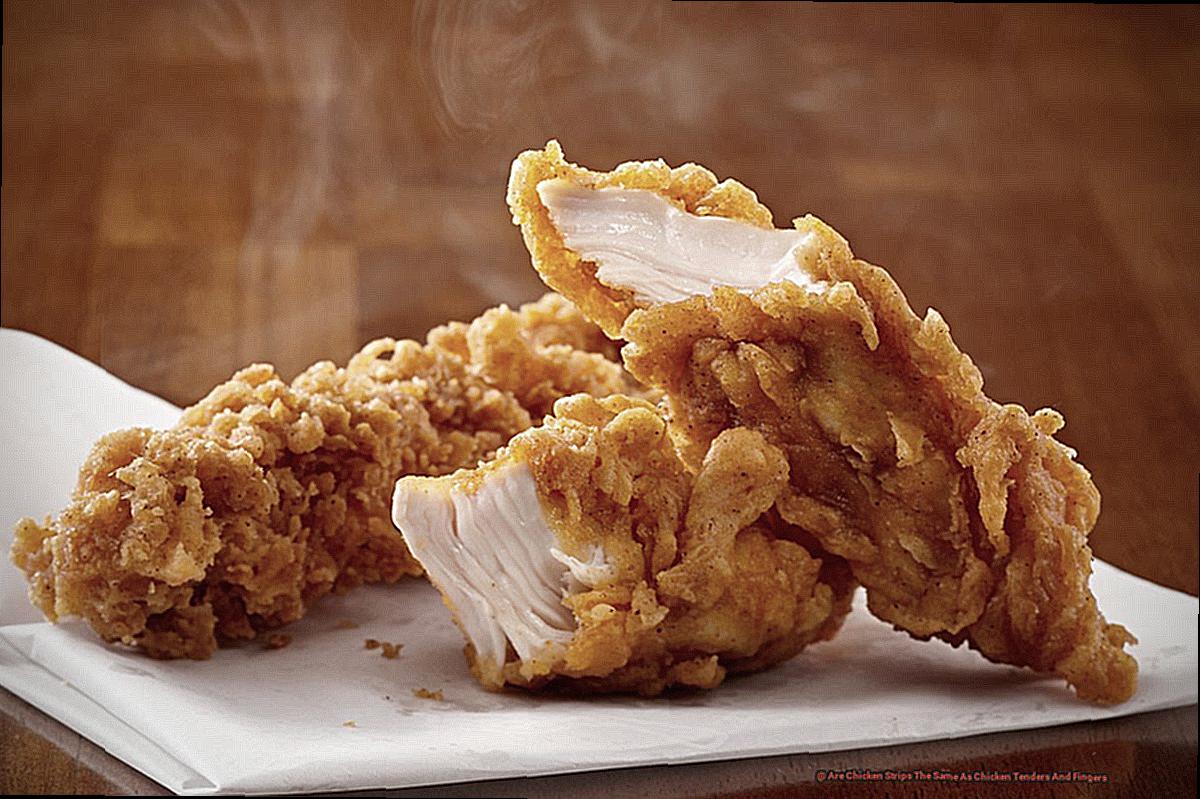
Chicken is a delicious and versatile protein that can be prepared in countless ways.
From crispy fried to juicy grilled, there’s a chicken dish for every palate. But when it comes to finger foods, three terms often get mixed up: chicken strips, tenders, and fingers.
So if you’ve ever pondered the differences or wondered if they’re all just different names for the same thing, keep reading as we dive into the world of chicken strips, tenders, and fingers.
Are Chicken Strips The Same As Chicken Tenders And Fingers?
Contents
- 1 Are Chicken Strips The Same As Chicken Tenders And Fingers?
- 2 The Origins of These Popular Chicken Options
- 3 What Sets Chicken Strips Apart from Tenders and Fingers?
- 4 A Closer Look at the Preparation Methods for Each Option
- 5 Size Matters: Comparing the Sizes of Chicken Strips, Tenders, and Fingers
- 6 Texture Talk: How Breading Can Make a Difference in Taste and Mouthfeel
- 7 Flavor Variations: Seasonings and Marinades Used in Chicken Strips, Tenders, and Fingers
- 8 Conclusion
If you’ve ever been to a fast food restaurant or browsed the frozen food section of a grocery store, chances are you’ve come across chicken strips, tenders, and fingers. But have you ever wondered if they are all the same thing? Many people use these terms interchangeably, but as an expert on the topic, I’m here to settle this debate once and for all.
First things first, let’s define each term. Chicken strips are thin slices of chicken breast that are coated in breading or batter and deep-fried. They are usually long and thin in shape, resembling a strip or plank. Chicken tenders, on the other hand, are small, boneless pieces of chicken that come from the tenderloin. They are also coated in breading or batter and deep-fried, but they tend to be more irregular in shape compared to chicken strips. Lastly, chicken fingers are similar to chicken tenders in terms of preparation and appearance. However, they may be slightly thicker and larger in size compared to tenders.
Now that we know what each term means, let’s dive into the key differences between them.
Preparation:

- Chicken strips are made from thin slices of chicken breast.
- Chicken tenders come from the tenderloin part of the chicken.
- Chicken fingers may be made from other parts of the chicken such as the thigh or wing.
Size:
- Chicken strips are usually longer and thinner compared to tenders and fingers.
- Chicken tenders can vary in size but are generally thicker and more substantial than strips.
- Chicken fingers may be smaller in size compared to tenders.
Texture:
- Chicken strips usually have a thinner and crispier breading compared to tenders and fingers.
- Tenders have a thicker breading, while fingers may have a combination of both thick and thin breading.
Flavor:
- All three options can be seasoned with different spices or marinades.
- Due to their different sizes and breading textures, they may vary slightly in taste.
It’s important to note that while these are the general differences between chicken strips, tenders, and fingers, some restaurants or brands may use these terms interchangeably or have their own interpretation of what constitutes a strip, tender, or finger. So if you’re ever unsure, it’s always best to ask for clarification.
The Origins of These Popular Chicken Options
As a lover of chicken myself, I have always been curious about the origins of some of my favorite dishes. And as an expert in the field, I can confidently say that chicken strips, tenders, and fingers have certainly made their mark on the culinary world. But where did these popular menu items actually come from? Let’s take a trip down memory lane and see how they evolved over time.
The 1960s: The Birth of Chicken Strips
It all started in the 1960s when Hardee’s, a fast food chain, introduced their “Chicken Strips” to the public. These were thin strips of chicken breast that were breaded and fried, similar to the way chicken nuggets are made. They were an instant hit and soon became a staple on Hardee’s menu.
The 1970s: Enter Chicken Fingers
In the 1970s, another restaurant chain called Dairy Queen came up with their own version of chicken strips, calling them “Chicken Fingers.” These were also breaded and fried, but were thicker and shaped like a finger. This gave them a unique texture and crunch, setting them apart from traditional chicken strips.
The 1980s: The Rise of Chicken Tenders
While the term “chicken tenders” may seem interchangeable with chicken strips or fingers, it actually has its own distinct origin. In the 1980s, they started appearing on menus in restaurants such as T.G.I. Friday’s. These were essentially the same as chicken strips but with a thicker and more tender cut of chicken. Hence the name “tenders.”
The 1990s: The Golden Age of Fast Food Chicken
With the rise of fast food chains such as McDonald’s and Burger King in the 1990s, these terms became even more popular. These chains offered their own versions of chicken strips and tenders, solidifying their place in the fast food world. And let’s not forget about the iconic dipping sauces that came along with them – barbecue, honey mustard, and ranch.
The Confusion Today
Today, these terms are used interchangeably by many people, causing confusion about whether they are actually the same or different. But as we’ve seen from their origins, they each have their own unique characteristics that set them apart.
What Sets Chicken Strips Apart from Tenders and Fingers?

When it comes to chicken dishes, there are a few options that immediately come to mind – strips, tenders, and fingers. These menu items are often used interchangeably and are popular choices at fast food restaurants. However, there are subtle differences between them that set them apart. As an expert in the culinary world, I am here to unravel the mystery and provide a comprehensive comparison of these beloved chicken options.
Cut of Meat:
The main difference between chicken strips and tenders/fingers lies in the cut of the meat. Strips are typically made from chicken breast meat, while tenders/fingers can be made from any part of the chicken, including the thigh or wing. This may seem like a small detail, but it can greatly affect the texture and tenderness of the meat.
Texture:
Due to the lean nature of chicken breast meat, strips are firmer and have a more solid texture compared to tenders/fingers. Tenders/fingers, on the other hand, tend to be juicier and more tender due to their higher fat content and being cut from different parts of the chicken. This difference in texture can greatly impact the overall eating experience.
Breading:
Another factor that distinguishes chicken strips from tenders/fingers is the breading. Strips usually have a thicker and crunchier breading, while tenders/fingers have a thinner and smoother breading. This can also affect the overall texture as well as the flavor of the dish.
Cooking Method:
The breading also plays a role in the cooking method for these menu items. Chicken strips are usually deep-fried, resulting in a crispy and golden exterior. Tenders/fingers are commonly pan-fried or baked, giving them a lighter and less greasy texture. This difference in cooking method can also affect the calorie and fat content of each dish.
Size:
In terms of size, chicken fingers are typically smaller than strips, with a slimmer and elongated shape. Tenders can vary in size but are generally larger and thicker than both strips and fingers. So if you’re looking for a heartier meal, tenders may be the way to go.
A Closer Look at the Preparation Methods for Each Option
As a chicken lover, you may have come across these popular options on menus or in grocery stores – chicken strips, tenders, and fingers. At first glance, they may all seem similar – after all, they are all made from chicken, right? But as an expert in the culinary world, I am here to unravel the mystery and highlight the subtle differences between these options.
Type of Meat Used
Let’s start with the basics – the type of meat used in each option. Chicken strips and tenders are typically made from breast meat, while chicken fingers can contain a mix of dark and white meat. This difference in meat can impact the flavor and texture of each option. Breast meat tends to be leaner and has a more delicate flavor compared to dark meat which tends to be juicier and more flavorful.
Breading Variations
Next up, let’s talk about the breading. Chicken strips and tenders are usually coated in a thicker breading, while chicken fingers may have a lighter coating. This can affect the level of crispiness and overall taste of each option. Some restaurants may also use different seasonings in their breading, which can add unique flavors to each dish.
Cooking Methods
The cooking method used can also impact the taste and texture of each option. Chicken strips and tenders are typically deep-fried to create a crispy exterior, while chicken fingers may be grilled or baked instead of fried. This can affect the overall taste and healthiness of each dish.
Size and Shape
Last but not least, let’s discuss the size and shape of these options. Chicken strips are usually longer and thinner, while tenders and fingers may be shorter and wider. This can impact the overall appearance and size of each dish when served.
Size Matters: Comparing the Sizes of Chicken Strips, Tenders, and Fingers
Are you someone who loves chicken but can’t decide between strips, tenders, or fingers? Or maybe you’ve always wondered what sets these options apart from each other? Well, look no further as we dive into the world of chicken sizes and explore the differences between these popular menu items.
Chicken strips, tenders, and fingers may seem similar at first glance, but they actually have distinct variations in size. Let’s take a closer look at their dimensions. Chicken strips are typically the longest and thinnest of the three options, ranging from 2-4 inches in length and about 1 inch in width. On the other hand, chicken tenders tend to be shorter and wider, with an average length of 3 inches and a width of 2 inches. Chicken fingers fall somewhere in between, with an average length of 2.5 inches and a width of 1.5 inches.
But why do these size differences matter? Well, let’s dig deeper. The size of these chicken options can also affect the number of pieces served per order. Generally, chicken strips come in larger portions with fewer pieces, while chicken fingers are smaller but come in larger quantities. This can be a crucial factor depending on your appetite or how many people you’re sharing with.
Moreover, the size variations can also impact the overall taste and texture of each option. Smaller pieces may cook faster and have a crispier exterior, while larger pieces may take longer to cook but have a juicier interior. So if you’re someone who loves a crispy crunch, opt for chicken fingers or strips. But if you prefer a juicier bite, go for chicken tenders.
It’s also worth noting that the size of these options can vary depending on the restaurant or brand. Some may have bigger or smaller versions of these chicken options, so it’s always a good idea to check the menu or ask the server for more information.
But let’s not forget the most important aspect when it comes to food – taste. While size and shape may play a role, it ultimately comes down to personal preference. Whether you prefer the longer and thinner strips or the shorter and wider tenders, the taste and texture will largely depend on factors such as the type of meat used, breading variations, and cooking methods.
Texture Talk: How Breading Can Make a Difference in Taste and Mouthfeel
Today, we’re diving into the world of chicken strips, tenders, and fingers and exploring how the breading used can make all the difference in taste and mouthfeel. As a lover of all things breaded and fried, I’ve done my fair share of research and taste testing to bring you the ultimate guide to understanding these popular chicken options.
Let’s start with the basics. All three variations are made from chicken breast meat, but their texture can vary due to the type of breading used. Chicken strips typically have a thicker and crunchier breading compared to tenders and fingers. This is because they are often coated in a batter or thicker breadcrumbs that create a crispy exterior when fried.
On the other hand, tenders and fingers have a thinner and softer breading. This makes them easier to bite into and gives a more delicate texture. The type of breading used can also impact the overall taste of the chicken. For example, panko breadcrumbs may give a lighter and crispier texture compared to traditional breadcrumbs.
But it’s not just about the type of breading – the amount matters too. More breading on each piece of chicken can result in a heavier and denser texture, while less breading can lead to a lighter and juicier bite. So if you’re looking for a heartier meal, opt for chicken strips with extra breading. But if you’re in the mood for something lighter, tenders or fingers may be your go-to.
The cooking method also plays a crucial role in the texture of these tasty treats. Deep-fried chicken strips, tenders, or fingers will have a crispier exterior compared to baked or grilled ones. However, don’t discount the latter options – they can still provide delicious results with a slightly different texture.
But do keep in mind that not all chicken strips, tenders, and fingers are created equal. Some restaurants may use different techniques or ingredients in their breading process, resulting in variations in texture even within the same category of chicken. This is where personal preference and individual preparation methods come into play.
Flavor Variations: Seasonings and Marinades Used in Chicken Strips, Tenders, and Fingers
When it comes to chicken, there are endless possibilities for flavor variations. And one of the most beloved chicken dishes is the humble chicken strip, tender, or finger. But did you know that these seemingly similar dishes can actually have vastly different flavors? Let’s dive in and explore how seasonings, marinades, and breading can greatly impact the taste of these popular chicken dishes.
The Basics:
Before we get into the nitty-gritty of flavor variations, it’s important to understand the basics. Chicken strips, tenders, and fingers all come from the breast meat of the chicken, but differ in terms of shape and size. Strips are long and thin, tenders are thicker and more cylindrical, and fingers are small bite-sized pieces. Now, let’s move on to what really makes them stand out – their unique flavors.
Seasonings:
The first thing that comes to mind when we think of flavor is seasoning. Traditional chicken strips are often coated in a simple blend of salt, pepper, and garlic powder. This classic combination gives a savory and slightly garlicky taste. On the other hand, tenders and fingers can have more complex flavors such as Cajun or barbecue seasoning. These add a spicy kick or smoky sweetness to the dish.
Marinades:
While seasonings are applied as a dry rub, marinades involve soaking the chicken in a liquid mixture before cooking. This allows for deeper penetration of flavor into the meat. For example, teriyaki marinade can give a sweet and tangy flavor to tenders and fingers. Some restaurants and fast food chains even have their own signature marinades for their chicken products, making them stand out from the rest.
Breading:
Another factor that can greatly impact the flavor of chicken strips, tenders, and fingers is the type of breading used. Panko breadcrumbs, for example, can give a crispier texture compared to traditional breadcrumbs. This adds a satisfying crunch to the chicken. Some restaurants even use unique breading, such as crushed cornflakes or potato chips, to add an extra layer of flavor.
Conclusion
In conclusion, chicken is a versatile and mouth-watering protein that can be prepared in countless ways. From crispy fried to succulent grilled, there’s a chicken dish for every taste. But when it comes to finger foods, the terms chicken strips, tenders, and fingers often cause confusion.
After exploring the world of these popular chicken options, it’s evident that they are not interchangeable. Chicken strips are thin slices of breast meat coated in breading and deep-fried, while tenders are small pieces of tenderloin also coated in breading. Chicken fingers may vary in size and can be made from different parts of the bird.
The origins of these dishes can be traced back to the 1960s when fast food chains like Hardee’s introduced their famous “Chicken Strips.” Since then, they have evolved and become a staple on menus at restaurants and fast food joints alike.
Although size may seem insignificant, it can greatly impact the taste and texture of these dishes. Smaller pieces may cook faster and have a crispier exterior, while larger ones take longer but boast a juicier interior.
But what truly sets these options apart is their flavor profiles. Seasonings, marinades, and breading all play vital roles in creating unique tastes for each dish. From classic salt and pepper to tangy teriyaki marinade or crunchy panko breadcrumbs – there’s something to satisfy every palate.
So next time you’re craving some delectable finger foods, remember that size matters but flavor reigns supreme.


